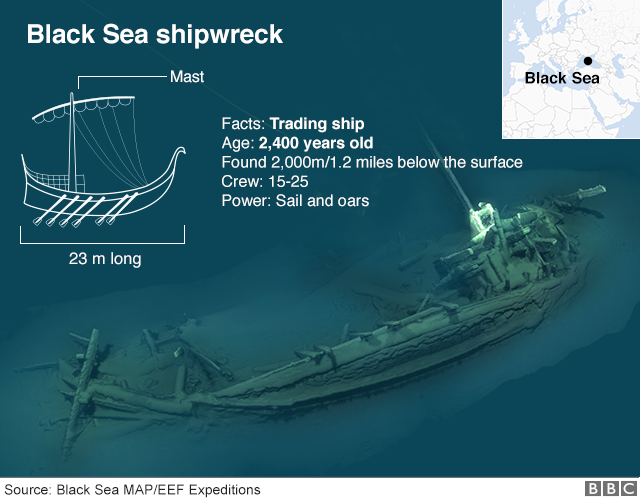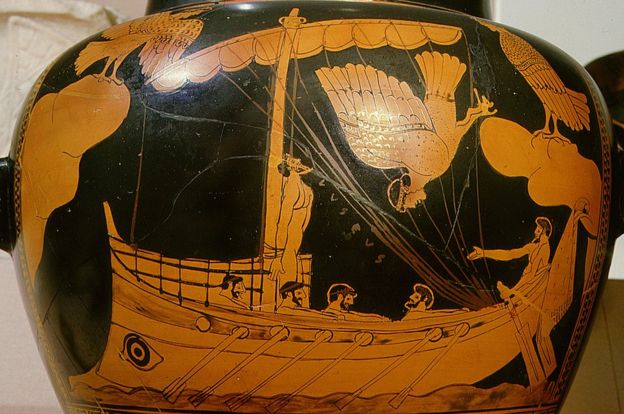This is definitely for your Just Too Cool file.
It hit the spot this morning in particular, because Anthony Esolen’s new book begins with the figure of Odysseus, trapped by Calypso, longing to go home.
Read on.
From BBC:
Shipwreck found in Black Sea is ‘world’s oldest intact’
A Greek merchant ship dating back more than 2,400 years has been found lying on its side off the Bulgarian coast.
The 23m (75ft) wreck, found in the Black Sea by an Anglo-Bulgarian team, is being hailed as officially the world’s oldest known intact shipwreck.
The researchers were stunned to find the merchant vessel closely resembled in design a ship that decorated ancient Greek wine vases.
The rudder, rowing benches and even the contents of its hold remain intact.
“It’s like another world,” Helen Farr from the expedition told the BBC.
“It’s when the ROV [remote operated vehicle] drops down through the water column and you see this ship appear in the light at the bottom so perfectly preserved it feels like you step back in time.” [How cool would that have been?]
The reason the trading vessel, dating back to around 400 BC, has remained in such good condition for so long is that the water is anoxic, or free of oxygen. Lying more than 2,000m below the surface, it is also beyond the reach of modern divers.
“It’s preserved, it’s safe,” she added. “It’s not deteriorating and it’s unlikely to attract hunters.”
The vessel was one of many tracking between the Mediterranean and Greek colonies on the Black Sea coast. It was discovered more than 80km off the Bulgarian city of Burgas.
The team used two underwater robotic explorers to map out a 3-D image of the ship and they took a sample to carbon-date its age.
The vessel is similar in style to that depicted by the so-called Siren Painter on the Siren Vase in the British Museum. Dating back to around 480 BC, the vase shows Odysseus strapped to the mast as his ship sails past three mythical sea nymphs whose tune was thought to drive sailors to their deaths.
As yet the ship’s cargo remains unknown and the team say they need more funding if they are to return to the site. “Normally we find amphorae (wine vases) and can guess where it’s come from, but with this it’s still in the hold,” said Dr Farr.
“As archaeologists we’re interested in what it can tell us about technology, trade and movements in the area.”
Over the course of three years the academic expedition found 67 wrecks including Roman trading ships and a 17th Century Cossack trading fleet.





































In my youth I did quite a bit of deep (technical) diving in Lake Superior. We got all excited when we dove on a wreck that was 100 years old– but 2400 years!!
There might be some wine onboard–I would love to take a sip of a 2,400 year old wine!
Wine that’s been in anoxic-sulfidic water for 2+ millennia would be undrinkable. The hydrogen sulfide (rotten-egg gas) would have penetrated the seals and ruined it.
The Black Sea is stratified, because 4 or 5 major European rivers flow into it (the Danube, Don, Dnieper, Dniester, and — if you consider it a major one — the Southern Bug), with only one shallow outlet (the Bosporus). All that fresh water causes the surface waters to be less saline, and therefore less dense, than the deeper water. The sea never turns over, so oxygen doesn’t make its way to the depths.
The Greeks called the Black Sea the Euxine Sea (which means something like “friendly to strangers”). Nowadays geochemists refer to anoxic waters high in hydrogen sulfide as “euxinic.”
Seriously cool. That ship looks exactly like the one one pictures headed for Ithaca under rosy fingered Eos.